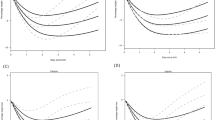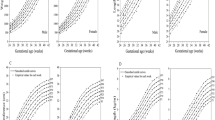Abstract
Background:
The lack of a valid and safe method for measuring length in critically ill preterm neonates has led to a primary focus on weight gain.
Local problem:
Paucity of valid length measurements, precluding the accurate analysis of growth patterns.
Methods:
Quality improvement project among infants < 29 weeks or small for gestational age < 35 weeks with embedded validation of (1) a caliper (infantometer) for length measurements and (2) length measurements during the first week to estimate birth length.
Intervention:
Implementation of valid methods to measure length.
Results:
We validated infantometer measurements and first week length measurements. The percentage of neonates with valid measurements during the first week rose from 10% to 78%, resulting in increased identification of classifiable growth patterns from < 10% to 89%.
Conclusions:
By increasing the percentage of neonates with valid length measurements in the first week postnatal, we identified an increased number of neonates with classifiable growth abnormalities.
This is a preview of subscription content, access via your institution
Access options
Subscribe to this journal
Receive 12 print issues and online access
$259.00 per year
only $21.58 per issue
Buy this article
- Purchase on Springer Link
- Instant access to full article PDF
Prices may be subject to local taxes which are calculated during checkout


Similar content being viewed by others
References
Fenton TR, Premji SS, Al-Wassia H, Sauve RS. Higher versus lower protein intake in formula-fed low birth weight infants. Cochrane Database Syst Rev 2014:CD003959.
Griffin IJ, Tancredi DJ, Bertino E, Lee HC, Profit J. Postnatal growth failure in very low birthweight infants born between 2005 and 2012. Arch Dis Child Fetal Neonatal Ed. 2016;101:F50–5.
Raiten DJ, Steiber AL, Carlson SE, Griffin I, Anderson D, Hay WW, et al. Working group reports: evaluation of the evidence to suupport practice guidelines for nutritional care of preterm infants-the Pre-B Project. Am J Clin Nutr. 2016;103:648S–78S.
Ehrenkranz RA. Early nutritional support and outcomes in ELBW infants. Early Hum Dev. 2010;86(Suppl 1):21–5.
Raiten DJ, Steiber AL, Hand RK. Executive summary: evaluation of the evidence to support practice guidelines for nutritional care of preterm infants-the Pre-B Project. Am J Clin Nutr. 2016;103:599S–605S.
Hay WW, Ziegler EE. Growth failure among preterm infants due to insufficient protein is not innocuous and must be prevented. J Perinatol. 2016;36:500–2.
Ehrenkranz RA, Dusick AM, Vohr BR, Wright LL, Wrage LA, Poole WK. Growth in the neonatal intensive care unit influences neurodevelopmental and growth outcomes of extremely low birth weight infants. Pediatrics. 2006;117:1253–61.
Rozé JC, Darmaun D, Boquien CY, Flamant C, Picaud JC, Savagner C, et al. The apparent breastfeeding paradox in very preterm infants: relationship between breast feeding, early weight gain and neurodevelopment based on results from two cohorts, EPIPAGE and LIFT. BMJ Open. 2012;2:e000834.
Ramel SE, Demerath EW, Gray HL, Younge N, Boys C, Georgieff MK. The relationship of poor linear growth velocity with neonatal illness and two-year neurodevelopment in preterm infants. Neonatology. 2012;102:19–24.
Rochow N, Raja P, Liu K, Fenton T, Landau-Crangle E, Göttler S, et al. Physiological adjustment to postnatal growth trajectories in healthy preterm infants. Pediatr Res. 2016;79:870–9.
Landau-Crangle E, Rochow N, Fenton TR, Liu K, Ali A, So HY, et al. Individualized postnatal growth trajectories for preterm infants. JPEN J Parenter Enteral Nutr. 2018; https://doi.org/10.1002/jpen.1138. [Epub ahead of print] PMID: 29419902.
Olsen IE, Harris CL, Lawson ML, Berseth CL. Higher protein intake improves length, not weight, z scores in preterm infants. J Pediatr Gastroenterol Nutr. 2014;58:409–416.
Ehrenkranz RA, Younes N, Lemons JA, Fanaroff AA, Donovan EF, Wright LL, et al. Longitudinal growth of hospitalized very low birth weight infants. Pediatrics. 1999;104:280–9.
Loÿs CM, Maucort-Boulch D, Guy B, Putet G, Picaud JC, Haÿs S. Extremely low birthweight infants: how neonatal intensive care unit teams can reduce postnatal malnutrition and prevent growth retardation. Acta Paediatr. 2013;102:242–8.
Moya F, Sisk PM, Walsh KR, Berseth CL. A new liquid human milk fortifier and linear growth in preterm infants. Pediatrics. 2012;130:e928–35.
De Jesus LC, Pappas A, Shankaran S, Li L, Das A, Bell EF, et al. Eunice Kennedy Shriver National Institute of Health and Human Development Neonatal Research Network. Outcomes of small for gestational age infants born at <27 weeks’ gestation. J Pediatr. 2013;163:e1–3.
Olsen IE, Lawson ML, Meinzen-Derr J, Sapsford AL, Schibler KR, Donovan EF, et al. Use of a body proportionality index for growth assessment of preterm infants. J Pediatr. 2009;154:486–491.
Clark RH, Olsen IE, Spitzer AR. Assessment of neonatal growth in prematurely born infants. Clin Perinatol. 2014;41:295–307.
Belfort MB, Gillman MW, Buka SL, Casey PH, McCormick MC. Preterm infant linear growth and adiposity gain: trade-offs for later weight status and intelligence quotient. J Pediatr. 2013;163:1564–69.
Ramel SE, Gray HL, Christiansen E, Boys C, Georgieff MK, Demerath EW. Greater early gains in fat-free mass, but not fat mass, are associated with improved neurodevelopment at 1 year corrected age for prematurity in very low birth weight preterm infants. J Pediatr. 2016;173:108–15.
Cooke RJ, Griffin I. Altered body composition in preterm infants at hospital discharge. Acta Paediatr. 2009;98:1269–73.
Kerkhof GF, Leunissen RW, Hokken-Koelega AC. Early origins of the metabolic syndrome: role of small size at birth, early postnatal weight gain, and adult IGF-I. J Clin Endocrinol Metab. 2012;97:2637–43.
Fewtrell MS, Doherty C, Cole TJ, Stafford M, Hales CN, Lucas A. Effects of size at birth, gestational age and early growth in preterm infants on glucose and insulin concentrations at 9-12 years. Diabetologia. 2000;43:714–17.
Wood AJ, Raynes-Greenow CH, Carberry AE, Jeffery HE. Neonatal length inaccuracies in clinical practice and related percentile discrepancies detected by a simple length-board. J Paediatr Child Health. 2013;49:199–203.
Griffin IJ, Pang NM, Perring J, Cooke RJ. Knee–heel length measurement in healthy preterm infants. Arch Dis Child Fetal Neonatal Ed. 1999;81:F50–5.
WHO Child Growth. Standards based on length/height, weight and age. Acta Paediatr Suppl. 2006;450:76–85.
Olsen IE, Groveman SA, Lawson ML, Clark RH, Zemel BS. New intrauterine growth curves based on United States data. Pediatrics. 2010;125:e214–24.
Fenton TR, Kim JH. A systematic review and meta-analysis to revise the Fenton growth chart for preterm infants. BMC Pediatr. 2013;13:59.
Olsen IE, Lawson ML, Ferguson AN, Cantrell R, Grabich SC, Zemel BS, et al. BMI curves for preterm infants. Pediatrics. 2015;135:e572–81.
Lawn CJ, Chavasse RJ, Booth KA, Angeles M, Weir FJ. The neorule: a new instrument to measure linear growth in preterm infants. Arch Dis Child Fetal Neonatal Ed. 2004;89:F360–3.
Sanchez AM, Mize SG, Jimenez JM, Manroe BL, Rosenfeld CR, Tyson TE. Systems approach to the evaluation of maternal and neonatal care. Proc 12th Hawaii Int’l Conf Syst Sci. 1979;III:140–151. Selected Papers in Medical Information Processing
Acknowledgements
We thank all members of the team. Sandra Gosser, NNP, Jessica Horner, RN, Timothy Brannon, MD, Katherine Stumpf, MD, Pritha Nayak, MD, Eric Ortigoza, MD, Julie Mirpuri, MD, Rebecca Thomas, RN, Emily Lentz, RD, and Catherine Vanbeek, RN, NP, were essential for building consensus, helping with education, or information technology. Susan Chako, RN, Maria DeLeon, RN, and Maria Caraig, RN, were research coordinators for this study. Cheryl Lair, RD, Chen Du, RD, Elizabeth Brammer, RD, Audrey Edwards, RD, and Theresa Jacob, RD, dietitians at Parkland Hospital, obtained most stadiometer measurements for this study and participated in infantometer measurements, patient recruitment, assessments of growth, and laboratory results, and recommendations for nutritional interventions. Elen Petrosyan, RD, dietitian at Parkland Hospital, helped organizing the logistics of patient recruitment, measurements, and research planning. Jeannette P. Burchfield, RN, research coordinator at UTSW, extracted data from the NICU database. Some of the patients included in the QI described in the current manuscript were enrolled in a blinded randomized trial: Clinicaltrials.gov NCT02372136. We thank Dr. Mackenzie Frost for reviewing the manuscript. Preliminary results were presented as follows: Pavageau L., Rosenfeld C., Heyne R., Brown L.S., DeLeon M., Chacko S., Caraig M., Brion L.P., Validation of Serial Length Measurements in Preterm Infants in the Neonatal Intensive Care Unit (NICU). Presentation at Western Conference on Perinatal Research, American Academy of Pediatrics Section on Neonatal-Perinatal Medicine, Indian Wells, California, 01/11–13/17.
Author contributions
L.P. conceptualized and designed the study. She recruited patients into the study, obtained infantometer and tape measure measurements, collected data into spreadsheets, participated in the interpretation of the data, participated in the writing of the first draft of the manuscript, critically reviewed the revisions, and approved the final manuscript as submitted. C.R.R. and R.H. conceptualized and designed the study. He participated in the interpretation of the data, critically reviewed the revisions, and approved the final manuscript as submitted. L.S.B., MS, conceptualized and designed the study. He conducted statistical analyses, participated in the interpretation of the data, critically reviewed the revisions, and approved the final manuscript as submitted. J.W. collected data and analyzed growth patterns in 69 neonates. She critically reviewed the revisions and approved the final manuscript as submitted. C.L., RD, participated in study design and data collection, critically revised the revisions, and approved the final manuscript as submitted. L.P.B. conceptualized and designed the study. He collected data on growth, participated in the interpretation of the data, conducted statistical analyses, participated in the writing of the first draft of the manuscript, critically reviewed the revisions, and approved the final manuscript as submitted.
Funding
This study was supported by the George L. MacGregor Professorship (CR Rosenfeld) and by Children’s Medical Center Clinical Advisory Committee (CCRAC) – Senior Investigator Research Award – New Direction (L.P.B., 2015–17). The funding organization had no role in design and conduct of the study; collection, management, analysis, and interpretation of the data; preparation, review, and approval of the manuscript; and decision to submit the manuscript for publication
Author information
Authors and Affiliations
Corresponding author
Ethics declarations
Conflict of interest
The authors declare that they have no conflict of interest.
Electronic supplementary material
Rights and permissions
About this article
Cite this article
Pavageau, L., Rosenfeld, C.R., Heyne, R. et al. Valid serial length measurements in preterm infants permit characterization of growth patterns. J Perinatol 38, 1694–1701 (2018). https://doi.org/10.1038/s41372-018-0242-4
Received:
Revised:
Accepted:
Published:
Issue Date:
DOI: https://doi.org/10.1038/s41372-018-0242-4
This article is cited by
-
Contemporary definitions of infant growth failure and neurodevelopmental and behavioral outcomes in extremely premature infants at two years of age
Journal of Perinatology (2024)
-
Growth after implementing a donor breast milk program in neonates <33 weeks gestational age or birthweight <1500 grams: Retrospective cohort study
Journal of Perinatology (2023)
-
Quality improvement project designed to reduce disproportionate growth in extremely low gestational age neonates: cognitive neurodevelopmental outcome at 18–41 months
Journal of Perinatology (2021)
-
Optimizing individual nutrition in preterm very low birth weight infants: double-blinded randomized controlled trial
Journal of Perinatology (2020)
-
Association of age of initiation and type of complementary foods with body mass index and weight-for-length at 12 months of age in preterm infants
Journal of Perinatology (2020)



